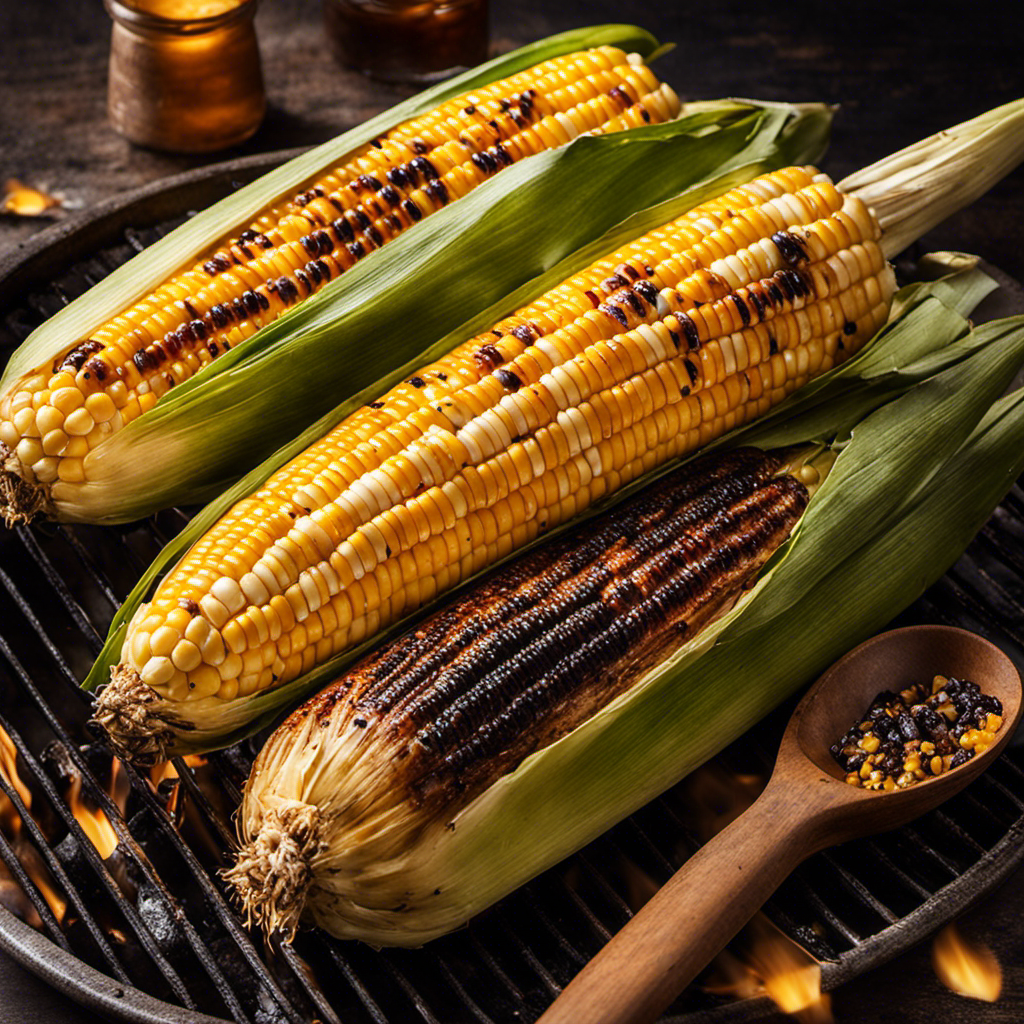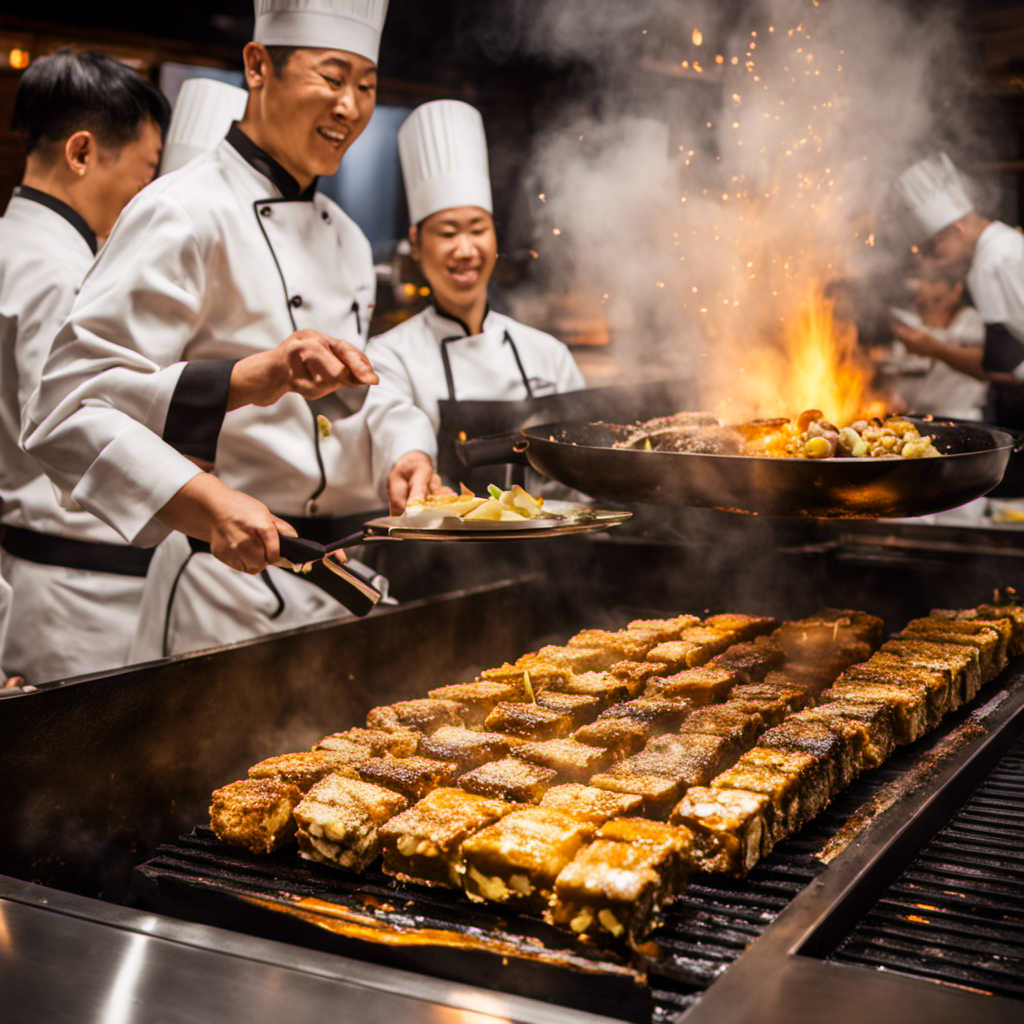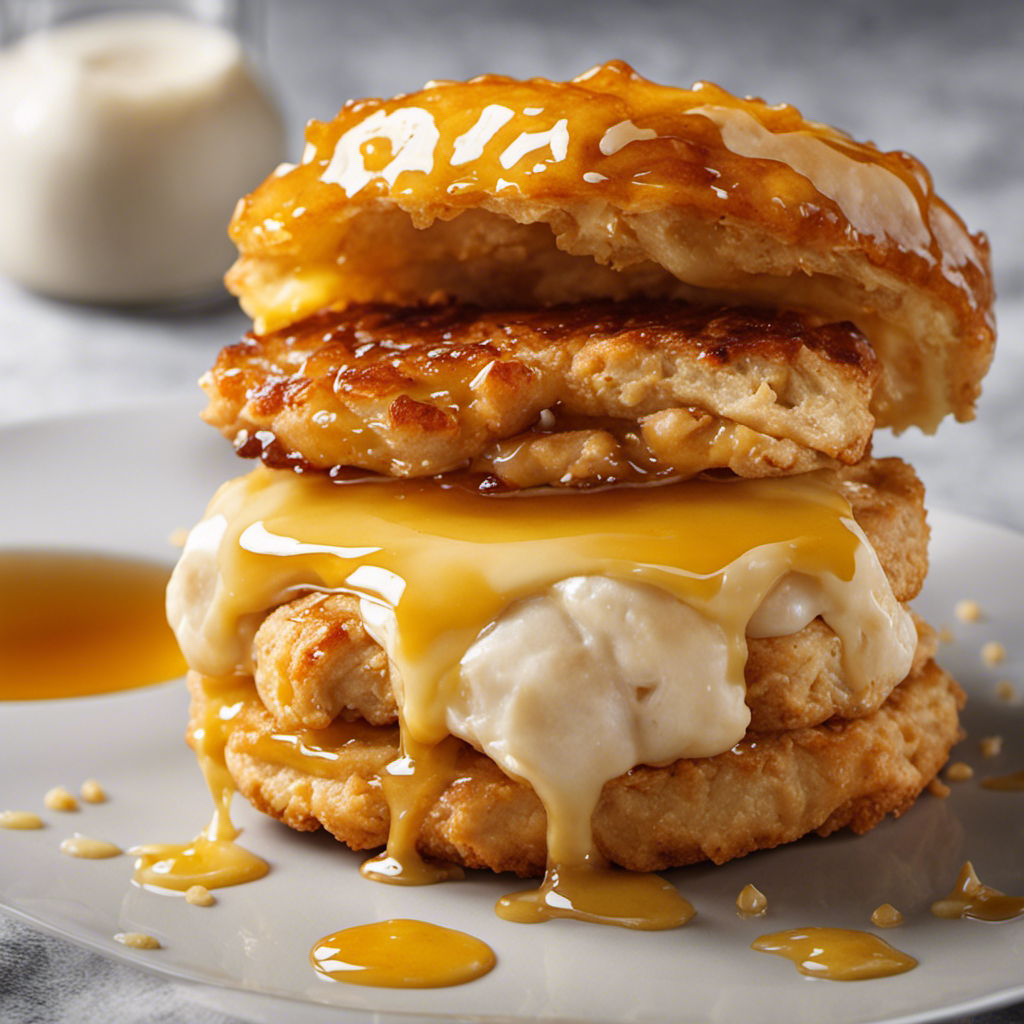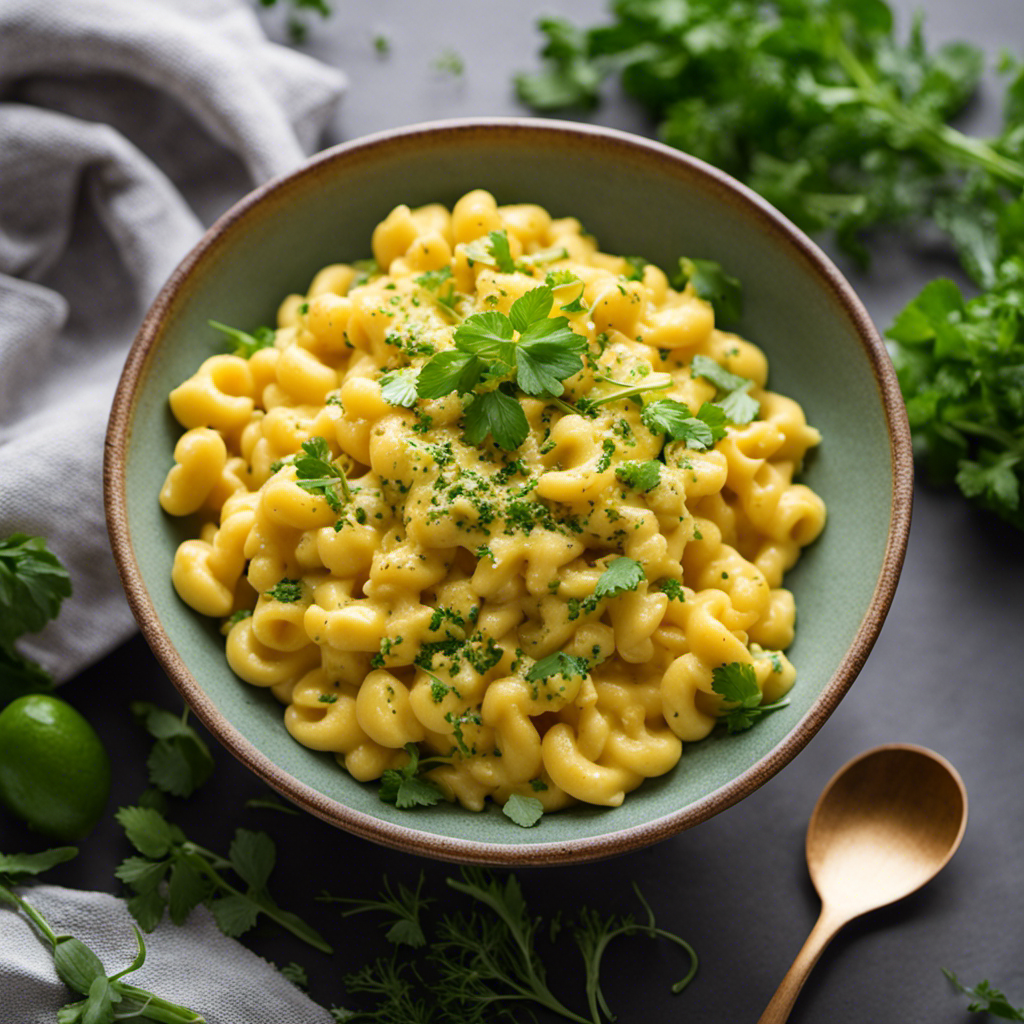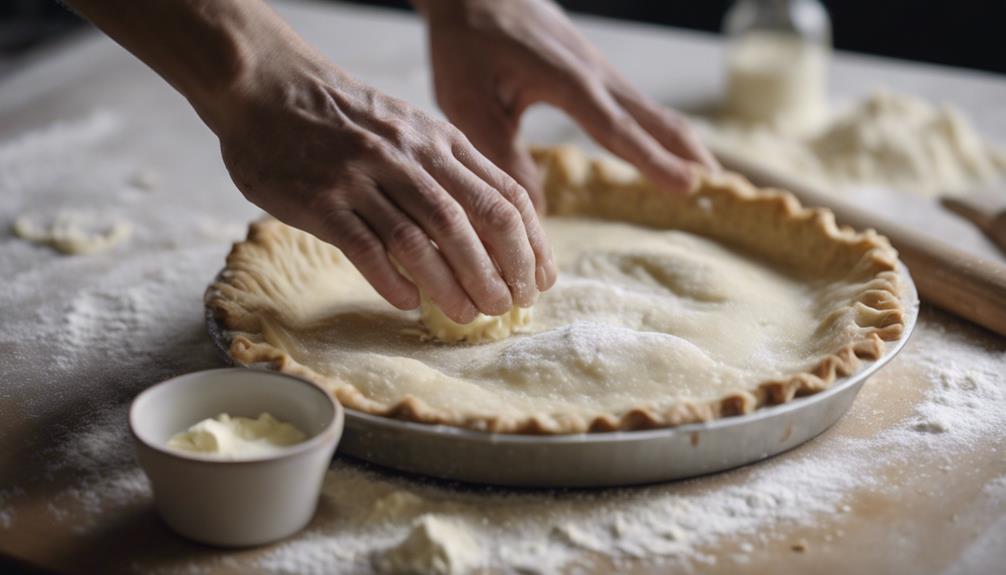I have always been a fan of butter, but when I came across corn butter, it completely changed the game.
The sweet and creamy combination of fresh corn and butter is irresistible.
In this article, I’ll show you how to make your own corn butter from scratch.
From selecting the best corn to blending the kernels with butter and seasonings, I’ll guide you through each step.
Get ready to elevate your dishes with this delicious and versatile condiment.
Key Takeaways
- Select fresh corn with firm kernels and bright green, tightly wrapped husks
- Shuck off the husk and remove the silk before using the corn
- Make corn butter by combining roasted corn kernels, garlic, salt, pepper, and softened butter
- Use corn butter as a spread, melted over grilled corn, tossed with pasta, or in savory recipes
Selecting the Best Corn
To select the best corn, you’ll want to feel for firm kernels and check for bright green husks. Look for varieties like sweet corn, which is known for its tender and juicy kernels. As you examine the corn, pay attention to the freshness indicators. The husks should be vibrant and tightly wrapped around the ears. Avoid corn with brown or wilted husks, as these are signs of less than optimal freshness.
Once you’ve selected your corn, it’s time to move on to the next step: shucking and cleaning the corn.
Shucking and Cleaning the Corn
First, grab a fresh ear of corn and start by shucking off the husk and removing the silk. Once you’ve cleaned the corn, it’s time to make some delicious corn butter.
Corn butter is a versatile and flavorful spread that can enhance the taste of many dishes. Made from fresh corn kernels and butter, it adds a rich and creamy touch to any meal. The benefits of corn butter are numerous. It is a great source of vitamins and minerals, and it can also be a healthier alternative to regular butter.
In addition to spreading it on bread or toast, there are many different uses for corn butter. It can be used as a topping for grilled vegetables, a base for sauces, or a flavorful addition to soups and stews.
Cooking the Corn
Once the corn is cleaned, it’s time to start cooking it to perfection. Cooking corn is a simple yet delightful process that brings out the natural sweetness and flavor of this versatile vegetable.
One of my favorite ways to enhance the taste of corn is by using a delicious corn butter recipe. This creamy and savory butter is made by combining softened butter with roasted corn kernels, garlic, and a touch of salt and pepper. It adds a rich and decadent flavor to any dish.
You can use corn butter in a variety of ways, such as spreading it on freshly baked bread, melting it over grilled corn on the cob, or tossing it with pasta for a flavorful sauce.
Now, let’s move on to the next step: removing the corn kernels.
Removing the Corn Kernels
When it comes to removing corn kernels, there are several methods and tools that can make the process easier and more efficient. Whether you prefer using a knife, a corn stripper, or a corn grater, each method has its own benefits and drawbacks.
In this discussion, I will explore these different extraction methods, discuss the various tools available, and share some tips for efficiently removing corn kernels.
Corn Kernel Extraction Methods
To extract the corn kernels, you’ll want to start by cutting off the tips of the corn cobs. This will expose the plump, juicy kernels hidden beneath the husk.
Once the tips are removed, firmly hold the cob at the base and slide a sharp knife downwards, allowing the kernels to come off in a satisfying cascade. Alternatively, you can use a special corn kernel removal tool, which neatly and efficiently separates the kernels from the cob.
The extracted kernels can then be used to make delectable corn butter recipes. Corn butter, a creamy spread made from pureed corn kernels, offers a multitude of benefits. It’s a great source of fiber, antioxidants, and vitamins, adding a healthy twist to your meals. Plus, its rich and buttery flavor adds a delightful touch to any dish.
Tools for Removing Kernels
Now that we’ve learned how to extract corn kernels efficiently, let’s move on to the next step in our journey to make delicious corn butter. But before we dive into the corn butter recipes and creative uses for this golden spread, we need to talk about some handy tools that will make removing kernels a breeze.
One of my favorite tools for this task is a corn stripper. This nifty gadget effortlessly removes the kernels from the cob, saving you time and effort. Another option is a sharp chef’s knife, which allows for precise cutting and gives you control over the size of the kernels.
With these tools at your disposal, you’ll be ready to explore the many possibilities of corn butter. From using it as a spread on toast to incorporating it into savory recipes, the versatility of corn butter is truly remarkable.
Now that we have our tools sorted, let’s move on to some tips for efficient removal of corn kernels.
Tips for Efficient Removal
With the corn stripper or chef’s knife in hand, you’ll want to firmly hold the cob of corn in a vertical position for efficient removal of the kernels. This technique allows for better control and precision, ensuring that you get the most out of each ear of corn.
To save time and make the process even more efficient, try placing a small bowl upside down inside a larger bowl. This creates a stable base for the corn cob, making it easier to strip the kernels without them flying all over the place.
Another time-saving technique is to use a bundt pan. Simply insert the corn cob into the hole in the center of the pan and strip the kernels down into the pan. This way, the pan catches all the kernels, keeping your workspace clean and preventing any from rolling away.
Blending the Corn Kernels
First, you’ll want to toss the corn kernels into a blender and let it do its magic. Blending techniques are crucial for creating a smooth and creamy consistency for your corn butter. Depending on your preference, you can choose to blend the corn kernels for a shorter time for a chunkier texture, or blend it longer for a smoother spread.
The blender effortlessly breaks down the kernels, releasing their natural sweetness and creating a vibrant yellow mixture. But blending corn kernels isn’t just limited to making corn butter. It can also be used to make delicious corn soups, creamy corn dips, or even corn-based desserts.
Now that the corn kernels are blended to perfection, it’s time to move on to the next step: adding butter and seasonings.
Adding Butter and Seasonings
When it comes to adding flavor to our food, seasoning combinations can make all the difference. In this discussion, I’ll be exploring the best seasoning combinations to enhance the taste of various dishes.
Additionally, we’ll dive into the age-old debate of butter versus margarine, examining the pros and cons of each.
Finally, for those looking for alternative options, we’ll explore some butter substitutes that can be used in cooking and baking.
Best Seasoning Combinations
One popular seasoning combination for corn butter is a mix of garlic powder, paprika, and black pepper. This combination adds a delicious kick to your grilled corn, enhancing its natural sweetness and smoky flavor. But don’t limit yourself to just these seasonings!
Here are some creative ways to use corn butter and elevate your grilled corn game:
- Add a sprinkle of chili powder and lime juice for a tangy and spicy twist.
- Mix in some fresh herbs like cilantro, parsley, or basil for a burst of freshness.
- Experiment with different types of cheese, such as Parmesan or feta, to add a savory and creamy element.
- For a smoky and fiery flavor, try adding chipotle powder or hot sauce.
- If you’re feeling adventurous, sprinkle some cinnamon and brown sugar for a sweet and spicy combination.
Get creative with your corn butter seasonings and let your taste buds explore the endless possibilities!
Butter Vs. Margarine
Butter and margarine are two popular spreads that can be used in a variety of recipes. While margarine is made from vegetable oils and butter is made from cream, both have their own unique qualities.
Butter, with its rich and creamy flavor, is a staple in many kitchens. It adds richness and depth to baked goods and savory dishes.
Margarine, on the other hand, is often chosen as a healthier alternative due to its lower saturated fat content. However, recent research has shown that butter may not be as bad for us as previously thought. In fact, it contains essential nutrients like vitamins A, D, and E, as well as healthy fats that are essential for our body’s functions.
Alternative Butter Substitutes
Try using avocado as a healthier substitute for butter in your recipes. Avocado is not only creamy and delicious, but it also provides numerous health benefits. Here are some reasons why avocado makes a great alternative spread:
- Avocado is rich in healthy fats, which can help reduce bad cholesterol levels and lower the risk of heart disease.
- It is packed with vitamins and minerals, such as vitamin K, vitamin E, and potassium, which are essential for overall health.
- Avocado is a vegan butter option, making it suitable for those following a plant-based or dairy-free diet.
With its smooth texture and mild flavor, avocado can be used in a variety of recipes, from baked goods to savory dishes. It adds a creamy richness without the saturated fats found in butter.
Now that we have explored alternative butter substitutes, let’s move on to the next step: mixing and chilling the corn butter.
Mixing and Chilling the Corn Butter
When you’re ready to mix and chill the corn butter, start by combining all the ingredients in a bowl.
The mixing techniques for corn butter are simple yet essential to achieve the perfect consistency. Using a fork or a whisk, vigorously mix the softened butter, corn kernels, salt, and any additional seasonings until well combined.
You want the corn kernels to be evenly distributed throughout the butter, adding a delightful crunch to every bite.
Once mixed, transfer the corn butter to a container with a lid and place it in the refrigerator for at least 1 hour to chill. This chilling time allows the flavors to meld together and the butter to firm up.
The result is a smooth and creamy corn butter that is perfect for spreading on toast or using in your favorite recipes.
Storing and Using Corn Butter
To store your corn butter, simply transfer it to an airtight container and refrigerate it until ready to use. This ensures that your corn butter remains fresh and flavorful for an extended period of time.
But what else can you do with your corn butter? Let me share some creative uses:
- Spread it on freshly baked bread or warm cornbread for a delicious twist on traditional butter.
- Melt it and drizzle it over steamed vegetables or grilled corn for a burst of flavor.
- Use it as a base for savory sauces or dressings to elevate your dishes.
The possibilities are endless when it comes to using corn butter. Experiment and discover your own unique ways to incorporate this creamy and rich condiment into your favorite recipes.
Frequently Asked Questions
Can I Use Frozen Corn Instead of Fresh Corn to Make Corn Butter?
Yes, you can use frozen corn instead of fresh corn to make corn butter. However, using fresh corn has its benefits as it adds a vibrant flavor and texture that may be lacking in frozen corn.
Can I Use Margarine Instead of Butter in This Recipe?
I prefer using butter in my recipes because it adds a rich flavor and creamy texture. Margarine can be used as a substitute, but keep in mind that it may affect the taste and health implications.
How Long Can I Store Corn Butter in the Refrigerator?
The shelf life of corn butter in the refrigerator depends on proper storage. It can typically be stored for up to a week. Make sure to keep it at a consistent temperature of 40°F or below to maintain freshness.
Can I Use Canned Corn Instead of Fresh Corn?
Using canned corn instead of fresh corn is an option for making corn butter. However, fresh corn brings a vibrant, sweet flavor and a satisfying crunch that enhances the taste and texture of the butter.
Can I Add Other Vegetables or Herbs to the Corn Butter for Additional Flavor?
Adding vegetables and herbs to corn butter can enhance its flavor, but it’s important to consider the pros and cons. Some great combinations include roasted red peppers and cilantro, or jalapenos and lime for a spicy kick.
Conclusion
Well, folks, there you have it – the ultimate guide to making corn butter.
I hope you’ve enjoyed this journey into the world of creamy, buttery goodness.
From selecting the best corn to mixing and chilling the corn butter, we’ve covered it all.
Now, you can elevate your cooking game to a whole new level with this delectable spread.
So go ahead, grab some corn, get your blender ready, and prepare to amaze your taste buds.
Remember, corn butter isn’t just a condiment, it’s a culinary experience.
Happy buttering!
